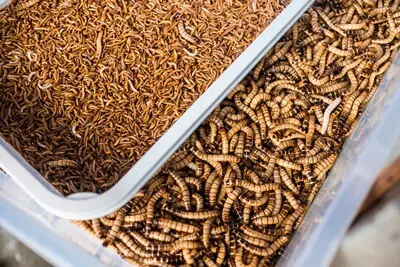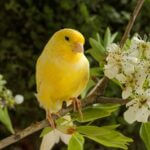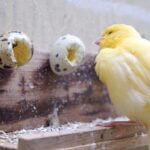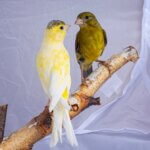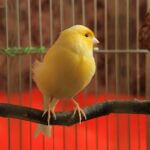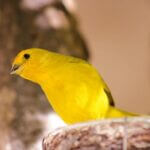Last Updated on: 28th September 2022, 12:11 pm
For most owners, providing mealworms for their canaries is as simple as going to a pet store and purchasing whichever brand appeals to their budget. However, knowing the different mealworms available and their health benefits for your canary can be helpful.
Mealworms aren’t an individual species of insect. Rather, they’re the larval stage of two species of darkling beetle, namely:
- Yellow mealworm beetle (tenebrio molitor)
- Mini mealworm beetle (tenebrio obscurus)
Although mealworm beetles are native to Europe, they’re distributed worldwide. They’re commonly found in dry and dark areas with little disturbance. Common habitats include:
- Stored grain products
- Damaged grain residue
- Chicken feed
They derive their nourishment from the grains and other foodstuffs they live in. This helps round out their nutritional profile when offered to canaries and other insect-eating animals.
Because canaries eat insects in the wild, you may wonder if the common feeder insect, the mealworm, is a suitable dietary addition. So, let’s examine how a canary can benefit from eating mealworms.
Do Canaries Like Mealworms?
Canaries consume insects in the wild, so they like mealworms as a snack. Despite being granivores, according to Biochemistry and Physiology, canaries require protein for 16.5-21.9% of their diet.
This is often derived from seeds and grains, but there are times when canaries can’t glean the full nutritional profile they need this way. To compensate, they find insects to fulfill this need, including:
- Beetles
- Spiders
- Caterpillars
These are more difficult to find in pet stores, so many owners opt for feeder insects, like:
- Mealworms
- Waxworms
- Crickets
Due to a canary’s small size, different worm species are ideal.
Are Canaries Allowed To Eat Mealworms?
Mealworms are safe to feed canaries. According to Foods, mealworms are non-toxic and highly nutritious, with a high protein content. This makes them valuable in the following ways:
- A treat used to reward a canary.
- Supplement to promote weight gain after an illness.
- A source of extra nutrition during molting and the breeding season.
You can offer mealworms to canaries as an occasional protein supplement.
Can Canaries Eat Dried Mealworms?
While mealworms are best fed live, commercially canned and dried mealworms are popular. They contain the same nutritional value as live mealworms, although they contain little water content.
Live mealworms are preferred, as they offer enrichment to your canary. It’ll have the authentic experience of pecking at live bugs like it would if foraging in the wild.
How To Grow Mealworms for Your Canaries
When growing mealworms at home to feed your canaries, you’ll need:
- Plastic containers
- Wheat bran or wheat flour
- Starter culture of about 300 worms
With these supplies on hand, you can use this plan to breed and raise mealworms:
- Fill the container with wheat flour or wheat bran.
- Do this to a thickness of about 3 cm so that the substrate bed is established.
- Place a few thin slices of potatoes inside the container to provide moisture.
- Introduce your starter culture of 300 worms into the container.
- Keep the container at room temperature (no more than 75 degrees Fahrenheit).
After a couple of weeks, the mealworms will turn into creamy pupa and black mealworm beetles about 3 days later. Then, the beetles will proceed to lay eggs, which will hatch into new mealworms.
You can use this colony to harvest the larvae and feed your canary with a steady supply. If you want to start another colony, transfer a portion of the substrate into a new container.
This will contain some eggs, which will eventually hatch into mealworms.
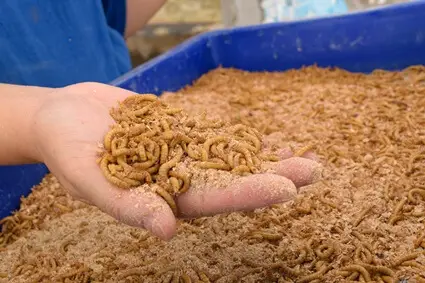
Life Cycle of a Mealworm
You don’t need to limit yourself to mealworms alone. By taking advantage of the insect’s life cycle, you can provide your pet canary with beetles to eat. These are a natural food canaries enjoy in the wild.
Better yet, grown darkling beetles have a higher protein content, although a reduced fat content. They consist of a high amount of fiber gained from their exoskeletons.
The mealworm beetle’s life cycle is divided into four main phases, including:
- Eggs
- Larvae (worms)
- Pupae
- Adult (beetle)
Mealworm beetles transition from one phase to the next based on:
- Humidity
- Temperature
- Availability of food and water
On average, it takes a mealworm beetle about 10-12 weeks to progress from an egg to its adult size.
However, some mealworms can take up to a year to complete their life cycle. With enough starters in your colony, you should have a regular supply of mealworm beetles at every stage.
Egg Stage
The life cycle begins in late spring or early summer when female beetles look for dark, isolated spots to deposit their eggs. On average, female mealworm beetles lay 200-300 eggs at a time.
The eggs typically appear as tiny, white dots measuring about 2 mm in diameter. It takes 1-4 weeks for the eggs to hatch and the larva to emerge.
Larval Stage
The larval stage lasts about 8-10 weeks; during this stage, the insect is a mealworm.
A mealworm is small when it hatches but will grow to be 1-1.5 inches long in a few weeks. The worm will need to molt and lose its hard outer shell to develop since it has a strong exoskeleton.
During the larval stage, the mealworm will molt 10-20 times. A newly molted worm will be fragile and whitish, but the exoskeleton will thicken soon.
Pupal Stage
Mealworms remain larvae until temperatures decrease, at which point they change into pupae and hibernate. Pupae are sturdy, C-shaped creatures that appear yellowish-white but darken as they mature.
Because the mealworm beetle has no mouth or anal opening during the pupal stage, it doesn’t feed. It also contains legs and wing buds, although these are inactive.
As a result, the pupa does little movement other than wriggling.
Adult Stage
Towards the beginning of summer, adult beetles emerge from their pupal state. They usually appear white or orange with a soft exoskeleton, but as their exoskeletons harden and solidify, they turn black.
While adult mealworm beetles are slow-moving, their ability to fly makes it possible for them to travel to other areas and infest them.
That makes containment important during this stage, and many owners choose to freeze the beetles to immobilize them for easier feeding. The average lifespan of an adult beetle is 3-12 months.

